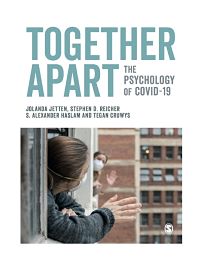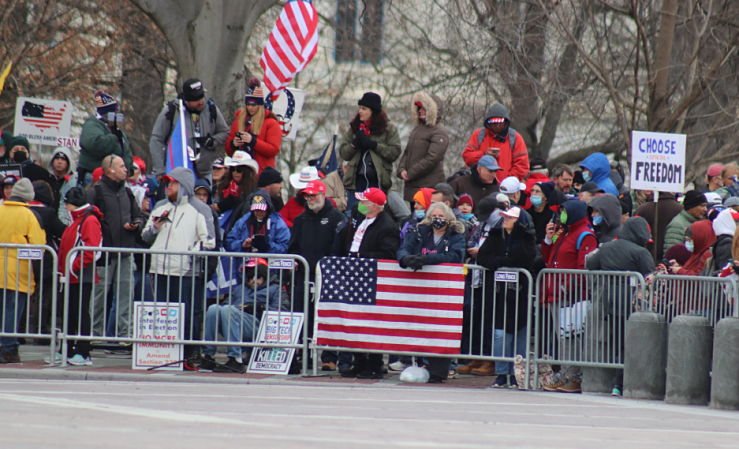Societal Polarization and COVID-19: Excerpt from ‘Together Apart’
This virus is dangerous. It exploits cracks between us. … Take as an example, ideology, or in one country it could be the differences along party lines. It exploits that. That’s why I said we need national unity and whoever has whatever ideology — whether that person is from left or right or center — they should work together to fight this virus to save these real people. If we don’t do that, this virus will stay longer with us to kill more people and we will lose more precious lives. (Dr. Tedros Adhanom Ghebreyesus, Director-General of the World Health Organization; World Health Organization, 2020).
On the surface, a global pandemic is not an ideological issue. However, in many parts of the world, political ideology was key to how individuals and nations viewed, discussed, and responded to COVID-19. There are at least two ways in which political division and polarization might shape our individual and collective responses to the COVID-19 crisis. First, partisan differences might slow a society’s response to COVID-19. Second, perceived political polarization can contribute to a breakdown in the fabric of society. This may shape not only individual protective behaviors, but also the nature of post-COVID-19 society. We will unpack these two points in turn.
Partisan differences create us-versus-them dynamics which undermine effective responses to disaster
As COVID-19 began to spread across the globe, political ideology and partisan splits influenced the way that many world leaders responded to the crisis, and the extent to which ordinary citizens viewed the virus as a real and present threat. For example, at a political rally in February, U.S. President Donald Trump declared: “The Democrats are politicizing the coronavirus. You know that, right? Coronavirus. They’re politicizing it” (Bump, 2020). In Brazil, although Health Minister Luiz Henrique Mandetta called for people to follow social isolation guidelines, President Jair Bolsonaro downplayed the threat of the virus and threatened to fire members of his cabinet who dissented (leading two of his health ministers to resign; Sandy & Milhorance, 2020).
As the pandemic unfolded, the fact that leaders in some countries blamed political rivals for using alarmist language served to accentuate pre-existing ‘us-versus-them’ dynamics. This was perhaps most obvious in the U.S., where political polarization was already on the rise, and where the looming Presidential election was a focus for divergent party interests (Schaeffer, 2020). As a result, a threat that was initially not political became political.
The dynamic can be understood in terms of the fit principle articulated within self-categorization theory (Oakes et al., 1994; see Chapter 2). More specifically, framing the threat of COVID-19 as an ‘us-versus-them’ issue increased the likelihood that people would perceive the virus through the lens of their political affiliation. In the U.S., Democrats and Republicans thus came to view the threat very differently as they converged on attitudes and beliefs that were (seen to be) consistent with divergent ingroup norms. In particular, Democrats prioritized health and well-being, whereas Republicans prioritized individual freedom and economic growth. Amongst other things, this meant that Democrats were more concerned about the virus (Butchireddygari, 2020). For example, data collected by the Pew Research Center in March indicated that while 59% of Democrat voters viewed COVID-19 as a major threat to the U.S. population, the same was true for only 33% of Republicans (Scanlan, 2020).
Such polarization is consequential because it fuels intergroup tensions and conflict; in countries like the U.S., an issue which arguably should not have been viewed through an ideological lens came to divide people along political lines — precisely at a time they desperately needed a coordinated and cohesive response to the pandemic.

Such polarization is consequential because it fuels intergroup tensions and conflict; in countries like the U.S., an issue which arguably should not have been viewed through an ideological lens came to divide people along political lines — precisely at a time they desperately needed a coordinated and cohesive response to the pandemic.
Problems were compounded by the fact that partisan perceptions of the virus also affected people’s health-related behavior. In the U.S., this is demonstrated by smartphone location data which showed that people in Republican-dominated regions were much less likely to practice physical distancing than those in Democrat regions, even after controlling for state policies, population density, and local COVID-19 cases and deaths (Allcott et al., 2020).
In these different ways, it is apparent that polarization and partisan bickering contributed to a slowed response to COVID-19 in countries like the U.S. (Van Bavel, 2020). As well as leading some people not to take adequate precautions, this also led others to campaign actively against preventative measures (e.g., in demonstrations to end the lockdown). These campaigns not only took a toll on social cohesion but also cost lives.
Polarisation promotes the breakdown of social fabric
While partisan differences no doubt slowed COVID-19 responses in a number of countries, the actual levels of polarization in society are only half the story. The extent to which people perceive there to be polarization in their society is also important. Indeed, there is evidence that the perceived level of polarization is a stronger predictor of negative outcomes than actual polarization (Enders & Armaly, 2019). More specifically, higher perceived polarization in society has been linked to reduced intergroup trust, efficacy, and altruism, as well as to increased outgroup hostility, selfishness, and competition (Arvan, 2019; Enders & Armaly, 2019). This negative impact on societal trust is robust across cultures (Rapp, 2016) and seems to increase in times of uncertainty (Sherman et al., 2009).
In times of crisis, the effects of polarization can create a tipping point for societies whose cohesion is chronically damaged. If people perceive their society to be polarized, they are more likely to think that it is breaking down (i.e., so that they are in a state of anomie; Crimston et al., 2020, unpublished manuscript). This in turn means that they are less likely to trust either their leaders or their fellow citizens to do the right thing. Social identity theorizing suggests that this in turn will make them less likely to want to do the right thing by their community. So at a time when what is really needed is social solidarity, one is likely instead to see a society where “everyone is out for themselves” (see also Section C).
We tested this prediction in the context of COVID-19. In line with the social identity analysis outlined above, we expected that higher perceived polarization might lead individuals to engage in personally self-protective behaviors — that is, behaviors intended to minimize their own risk of being infected with the virus (e.g., avoiding crowds and public spaces, washing hands more frequently; see Figure 7). At the end of March 2020, we surveyed 1000 adults across the U.S. and the U.K. to gauge their sense of the level of political polarization in their society and their attitudes towards the COVID-19 crisis. We found that people who perceived there to have been political polarization within their country over the past 10 years were more likely to believe that their government had responded in a chaotic and disorganized manner to the COVID-19 crisis. In other words, perceived polarization predicted a sense of COVID-related anomie. As predicted, this anomie was associated with an increase in self-protective behavior. Essentially, people who recalled a history of political division in their society were more likely to see a society in chaos during the pandemic, and to believe that to survive this pandemic, they needed to assume an individualistic stance in which they took responsibility for protection from the virus into their own hands.

Figure 7. The effects of perceived polarisation
Note: Perceived political polarization enhances the perception that the government’s response to COVID-19 was chaotic and disorganized (i.e., anomie). In turn, this is associated with (a) an increase in self-protective behaviors (that may slow the spread of the virus) and (b) more negative expectations about the future of society.
Engaging in more self-protective behaviors in the face of COVID-19 may have been a good thing in so far as it served to reduce the spread of the virus. However, perceived political polarization and anomie are likely to have other more negative long-term consequences. If people feel that their country has been politically divided, this does not bode well for their collective future (Liu & Hilton, 2005). Consistent with this supposition, we found that our respondents’ perceptions of political polarization prior to COVID-19 were indirectly associated with them having more negative expectations about the post-COVID-19 future. As with self-protective behaviors, this was driven by a heightened sense of anomie. More specifically, respondents’ negative expectations included doubts about the future vitality of their country and its economy, and increased pessimism about the future of humanity as a whole. So not only does seeing one’s country as politically divided in the past make you feel that society is breaking down in the present but it also makes you concerned that chaos will continue to reign in the future.
Political polarisation can be overcome by building a strong sense of “us”
The foregoing analysis suggests that COVID-19 represents not only a health crisis, but also a political one — at least in those societies where it serves to accentuate pre-existing divisions. What, then, can societies do to overcome political polarization? While political division and polarization are not new, to overcome a crisis of this scale it is essential for groups to unite at a superordinate level. As discussed in Section B, when making crucial decisions, leaders need to fix their eyes firmly on the well-being of their citizens, not their own political survival. Saving lives depends on political leaders and authorities taking quick and coordinated action, but this is only possible if partisan differences are put to one side (a conclusion also endorsed by The Lancet, 2020). As we saw in Chapter 3, this means that leaders need to engage in effective identity leadership by emphasizing that they speak for, and act on behalf of, all citizens regardless of their political loyalties (see also Chapters 7 & 20).
Fortunately, in the context of the COVID-19 crisis there were many instances of effective identity leadership that were not hampered by ideological squabbles or fractured politics. For example, Singapore has long been ruled by a single political party that maintains tight control over citizens and mass media (Barron, 2020). This fact (and the associated absence of partisan divisions) appears to have helped Prime Minister Lee Hsien Loong immediately set in motion a coordinated and effective government response (albeit one whose focus on the Singaporean ingroup neglected the circumstances of migrant workers, whose poor living conditions later became a site for major outbreaks of infection; Yea, 2020).
However, effective responses to COVID-19 have not been confined to authoritarian and one-party states. There have also been clear demonstrations of bipartisan unity in strong democracies with multiple major political parties. This was seen when the Dutch Prime Minister, Mark Rutte, appointed the opposition health minister to join the Government, after the sitting health minister collapsed from exhaustion and later resigned (Holroyd, 2020). It was also seen in South Africa, where all 14 political parliamentary parties worked together to develop measures aimed at mitigating the spread of the virus. According to President Cyril Ramaphosa, they “agreed that regardless of our political persuasions, our political differences, all of us share a common desire to keep our people safe” (Powell, 2020). Likewise, New Zealand’s Prime Minister, Jacinda Ardern, reacted quickly to curb the spread of the virus, repeatedly calling for cross-party unity to defeat COVID-19 (Duncan, 2020). This call for unity was reflected in the words of her primary political opponent, the leader of New Zealand’s National Party:
Today we could look backward at what’s been done well and perhaps not so well. It is not a time for that. We are where we are and we are all in this together. And today on the big questions, in this House and in New Zealand we agree, there’s no National or Labour, or Green or ACT or New Zealand First, just New Zealanders. (Bridges, 2020)
This is a model that other nations would have been wise to follow. Certainly, we imagine it is the preferred model for the many thousands of New Zealanders who might otherwise have lost their lives in the pandemic.
Explore the section of Together Apart on intergroup relations
Prejudice and Discrimination| Yuen J. Huo
Inequality | Jolanda Jetten
Common Identity and Humanity | John F. Dovidio, Elif G. Ikizer, Jonas R. Kunst, & Aharon Levy
Societal Polarization | Charlie R. Crimston & Hema Preya Selvanathan































































































